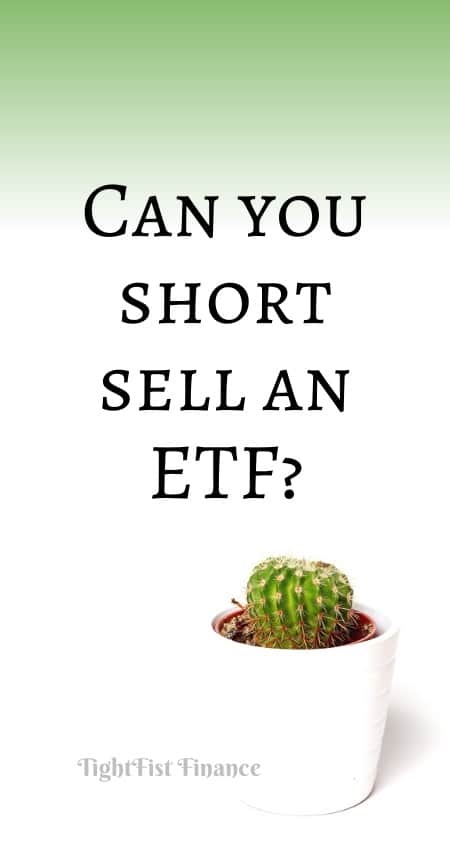Can you short sell an ETF?
Short sell an exchange traded fund by purchasing an inverse (bear) ETF or by trading with a brokerage which allows short selling. Most major indexes, like the S&P 500, have an inverse ETF which allows a short position. Alternatively, some brokerages will allow you to short stocks or ETFs upon request.
Imagine, shorting the next big market crash. Stocks tend to take the stairs on their way up and the elevator down!
Knowing the right time to short can be very profitable, but also risky.
Luckily for you, I’m going to show you how to short an ETF. I’ll even let you know some of the risks of shorting! Shorting is one tool for making money with the stock market.

This article may contain affiliate links which pays a commission and supports this blog. Thank you for your support!
Can you short sell an ETF?
It is possible to short sell an exchange traded fund. Exchange traded funds are traded in a similar manner to individual stocks. Therefore, you may short sell an ETF just like you would any other stock.
Exchange traded funds are a collection of different stocks. As a result, exchange traded funds can be bought, sold, or even shorted just like a normal stock would.
How do you short sell an ETF?
There are two different ways you can short sell an exchange traded fund. Specific brokerages will allow you to short any stock or exchange-traded fund. Alternatively, you can short an ETF by finding its respective inverse ETF.
Some brokerages, like Cobra Trading, will allow you to short sell any stock or ETF. Other brokerages may require you to request access to short selling. Keep in mind, not all brokerages will allow you to short sell.
Your other option is to find the inverse ETF for a specific index, like the S&P 500. An inverse ETF tracks the opposite performance of the underlying index fund or ETF.
For example, ProShares S&P 500 Short ETF ($SH) is the inverse of the S&P 500. If the S&P 500 goes up in value, $SH decreases in value. Therefore, if you think the S&P 500 is going to act bearish, you could buy $SH.
ProShares offers multiple Short ETFs for shorting specific indexes. Simply do a CTRL+F and search for ‘short’ to find different short ETFs. Note that some of these ETFs may be leveraged, where debt is used to amplify returns or losses.
Examples of ETFs you can short on ProShares includes DOW 30, Treasury Yields, S&P 500, Russell 2000, and NASDAQ 100. However, there are plenty of different exchange traded funds to choose from.
What are the risks of short selling?
Risks of short selling include short squeezes and paying additional brokerage fees to locate shares to short. Technically, there is no limit to how much money you can lose when short selling.
A short squeeze is when the share price increases in value so much you are forced to buy the shares. When borrowing money (margin), you may be asked to cover the cost of the shares if the price increases too much.
For example, maybe your brokerage allows you to borrow $10,000 worth of margin. You short sell a company currently trading at $2 per share and buy 5,000 shares. Overnight, the company receives good news which takes the share price to $20.
In this case, your margin may be called in or you’re asked to pay up. You’ve lost $18 per share, so you are forced to lose $90,000.
However, the share price increasing to $20 is just a very realistic example. Technically, there’s no limit to how high the price can increase.
Brokerages also charge a share locating fee for finding shares for shorting. These fees can be very expensive and you’re responsible for paying even if you lose money.
Click to Tweet! Please Share!Click To TweetSummary: Can you short an ETF?
As you can see, it is possible to short an exchange traded fund. ETFs are traded just like stocks, which means you can short ETFs as well. However, shorting a stock is not easy money and you need to be made aware of the risks.
The main risk to short selling is the price increasing when you thought it would drop. When you invest $1,000 in traditional investing for gains, the most you can lose is $1,000.
However, there is no limit to losses when it comes to short selling. The share price can increase 20%, 50%, 100%+, or even to the moon. You’re still responsible for paying for all losses.
Short sellers can also experience high fees when it comes to their brokerage. Brokerages will charge you fees for locating shares you can short.
In order to short sell, you may need brokerage approval or buy an inverse ETF. Not all brokerages have the ability to let you short sell. However, you can always buy an inverse ETF which tracks performance opposite to the underlying index.